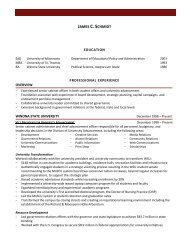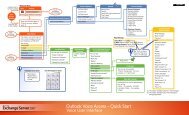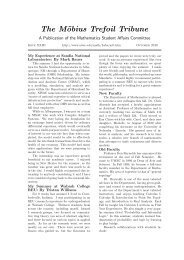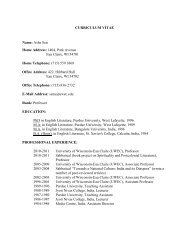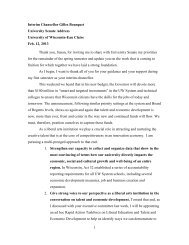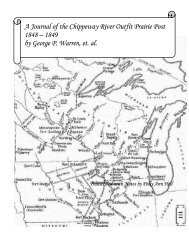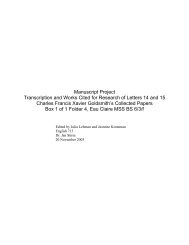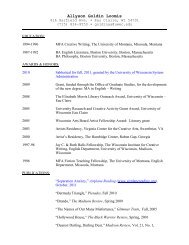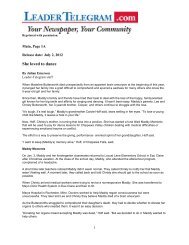Elam and Persia - University of Wisconsin-Eau Claire
Elam and Persia - University of Wisconsin-Eau Claire
Elam and Persia - University of Wisconsin-Eau Claire
You also want an ePaper? Increase the reach of your titles
YUMPU automatically turns print PDFs into web optimized ePapers that Google loves.
292<br />
Matt Waters<br />
near the end <strong>of</strong> the 7th century b.c. 44 While there is no definitive evidence linking these two<br />
Cyruses, by the same token, there is no compelling reason to disassociate them, despite difficulties<br />
with the identification.<br />
One problem with the identification is that Cyrus the Ansanite <strong>of</strong> PFS 93* did not label<br />
himself “king,” a title that Cyrus the Great attributed to all his forebears through Teispes. The<br />
label “the Ansanite” in <strong>and</strong> <strong>of</strong> itself does not warrant assumptions <strong>of</strong> political dominion. How<br />
does one reconcile this title with the royal title used by Cyrus for, we must assume, the same<br />
individual? An easy, but not necessarily satisfactory, answer is that this seal dates to a time before<br />
Cyrus became king <strong>and</strong>, thus, according to Cyrus’s genealogy, during the reign <strong>of</strong> Teispes. But<br />
why not then identify himself as the crown prince, i.e., the son <strong>of</strong> king Teispes, as does Hubankitin,<br />
son <strong>of</strong> king Sutur-nahhunte, on his seal? 45 The possibility should not be discounted that<br />
Cyrus the Great also (like many others) exaggerated his royal lineage.<br />
There is also the <strong>of</strong>ten-cited difficulty <strong>of</strong> reconciling the fact that Ashurbanipal’s Cyrus is<br />
called “king <strong>of</strong> Parsumas”—though note that this is an Assyrian label—while Cyrus the Great<br />
calls his gr<strong>and</strong>father “king <strong>of</strong> Ansan.” However, we should not place too much stock on this<br />
detail; consider that the title “king <strong>of</strong> <strong>Elam</strong>” used in Neo-Assyrian sources has no Neo-<strong>Elam</strong>ite<br />
counterpart. It should be considered a generic label for the typically more expansive Neo-<br />
<strong>Elam</strong>ite titulary such as that, for example, used by Sutruk-Nahhunte II: “I am the king <strong>of</strong> Ansan<br />
<strong>and</strong> Susa, exp<strong>and</strong>er <strong>of</strong> the realm, katru <strong>of</strong> <strong>Elam</strong> . . .” 46 Different labels from different sources<br />
cannot be reduced to a single st<strong>and</strong>ard <strong>of</strong> comparison.<br />
Sometime after Ashurbanipal’s sack <strong>of</strong> Susa in ca. 646 b.c., Cyrus, king <strong>of</strong> Parsumas <strong>and</strong> Pislumê,<br />
king <strong>of</strong> Hudimiri, <strong>of</strong>fered Ashurbanipal obeisance, according to the royal inscriptions<br />
because <strong>of</strong> fear <strong>of</strong> Assyrian might. Cyrus <strong>and</strong> Pislumê’s stereotyped response is recorded in two<br />
exemplars: Prism H2 <strong>and</strong> the Ishtar Temple inscription. 47 Pislumê is a hapax; 48 Hudimiri occurs,<br />
however, one other time (to my knowledge), in ABL 521 rev. 21–24, in the context <strong>of</strong><br />
Nabû-bel-sumati’s flight there from Assyrian forces, with no indication <strong>of</strong> pursuit. 49 Perhaps,<br />
at the time <strong>of</strong> this letter, Hudimiri was beyond Assyrian reach or influence. The annals passage<br />
emphasizes that Hudimiri had had no contact with Assyria before Ashurbanipal’s reign (lines<br />
15u–18u). This implies that it was not only “on the far side <strong>of</strong> <strong>Elam</strong>” (line 15u) but also that it<br />
was further removed from Assyria (<strong>and</strong> from <strong>Elam</strong>) than Parsumas, with which the Assyrians<br />
had had contact.<br />
In the prism inscription, Cyrus’s son, Arukku (also a hapax), was also sent to the Assyrian<br />
court. 50 The Ishtar temple inscription does not mention Arukku, only that both Cyrus <strong>and</strong> Pislumê<br />
sent their nobles ( LÚ MAH.MES) <strong>and</strong> tribute (tamartu). For Arukku, there is nothing else<br />
beyond his name <strong>and</strong> that he is described as Cyrus’s oldest (rabû) son. That he is only men-<br />
44. For example, Miroschedji 1985: 283–84; Stronach 1997a: 359; Briant 2002: 17–18, 878; Rollinger<br />
1999: 136–37; Vallat, this volume.<br />
45. For the seal, see Amiet 1973: 18 <strong>and</strong> 29, no. 34 (<strong>and</strong> pl. VI) <strong>and</strong> Miroschedji 1982: 61. For discussion<br />
see Waters 2000: 113–15. On Cyrus <strong>and</strong> his lineage, note Stronach 2003b: 255.<br />
46. See Waters 2000: 16 <strong>and</strong> 111–12. For katr(i), see Grillot-Susini 1987: 15 <strong>and</strong> Khacikjan 1998: 12. For<br />
occurrences <strong>of</strong> Ansan in 3rd- <strong>and</strong> 2nd-millennium b.c. <strong>Elam</strong>ite titulary, see references in Potts 2005: 15.<br />
47. Weidner 1931–32: 3–5 <strong>and</strong> Borger 1996: 191–92 (for Prism H2 iiu 7u–25u); Thompson 1933: 86 <strong>and</strong><br />
Borger 1996: 280–81 (for the Ishtar Temple inscription, lines 115–118). Both Parsumas <strong>and</strong> Hudimiri are described<br />
as on “the far side <strong>of</strong> <strong>Elam</strong>.” Note also Miroschedji 1985: 272–73 <strong>and</strong> Rollinger 1999: 118–20.<br />
48. Zadok (1984: 27, 35) includes this name in his <strong>Elam</strong>ite Onomasticon.<br />
49. De Vaan 1995: 271–72 <strong>and</strong> Waters 2000: 68–69.<br />
50. Schmitt etymologizes Arukku as an Iranian name, but this is disputed (in Schmitt 1998: 134–35).<br />
Offprint from:<br />
Javier Álvarez-Mon <strong>and</strong> Mark B. Garrison, eds.,<br />
<strong>Elam</strong> <strong>and</strong> <strong>Persia</strong><br />
ç Copyright 2011 Eisenbrauns. All rights reserved.



